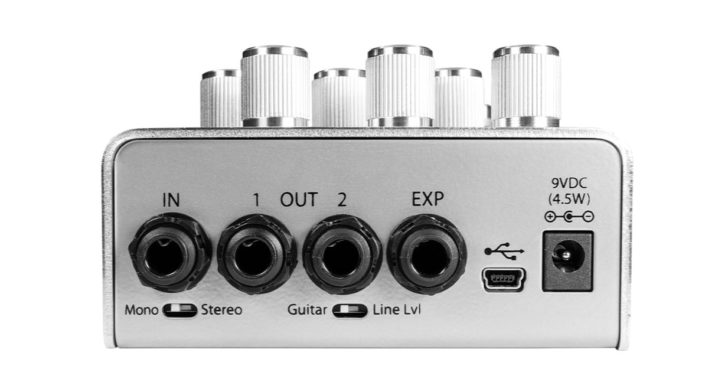Eventide Audio has introduced UltraTap, a new multi-tap delay pedal that delivers rhythmic delays, glitchy reverbs, huge pad-like volume swells, and modulated effects in a compact form.
The top panel offers direct control of twelve parameters, to create simple repeats or morph delays into chorus and reverb. The pedal’s Spread function controls the effective distance between up to 64 Taps, morphing from closely spaced at the beginning of the delays, to evenly spaced, then closely spaced at the end of the delays, letting you dial in song specific rhythmic spaces between taps.
Taper controls the level of subsequent Taps either fading them up, down or constant over time. The Slurm control can smear or slur Taps together to produce unique reverbs and choruses. The Chop and Speed/Rise/Release controls work together to allow unusual and expressive amplitude modulation of Taps to chop a sound source into stuttered rhythms.
Five presets can be accessed directly from the pedal using the Active and Tap footswitches, with up to 127 in total stored under the hood and accessible via MIDI or the Eventide Device Manager application (EDM). These two footswitches allow full performance control of Active (momentary or latching), Tap Tempo and Preset selection and loading.
On the rear panel, the multi-function Exp jack allows for the connection of an expression pedal, an external single Aux switch or a triple Aux switch for easy preset changing (up/down/load) as well as MIDI over TRS capabilities. Multiple bypass options are available – Buffered, Relay, DSP+FX or Kill Dry.
The rear panel USB jack provides a connection to a computer for use with EDM, software updates, and MIDI over USB control. The Guitar/Line Level switch allows level- matching with guitars, synths, FX loops or DAW interfaces. The UltraTap pedal also features mono/stereo ins and outs.
Features:
- Control the stereo image of taps to alternate between hard-panned and mono.
- Five presets loaded at your feet with dozens more available with Eventide Device Manager (EDM) software.
- Dual-action Active Footswitch is latching or momentary.
- Onboard LFOs and envelopes to chop the sound source into stuttered rhythms.
- Rear panel Guitar/Line Level switch for matching levels of guitars, synths, FX loops, or DAW interface.
- Map any combination of parameters to an Expression Pedal.
- Use a single Aux switch to Tap Tempo or a triple Aux switch for easy preset changing (up/down/load).
- MIDI capability over TRS (use with a MIDI to TRS cable or converter box) or USB.
- Multiple Bypass options: Buffered, Relay, DSP+FX, or Kill dry.
- Catch-up mode helps dial in your sound when toggling between presets/parameters.
- Eventide Device Manager PC or Mac application for software updates, system settings, and creating/saving presets.
Pricing and Availability
The UltraTap pedal is available now for $279 USD.


I’ve given up on digging too deep into stereo guitar pedals unless they’re up-front about where they sum the stereo signal. The ‘block-diagram’ in the manual of this thing is a not-very-funny joke.
Either the pedal sounds good, or it doesn’t. If you get hung up on technical details, you’re not focused on music.
It is possible to pay attention to technical details (during the pre-purchase research phase) and then focus on the music at a rehearsal or gig. They aren’t mutually exclusive tasks/skills.
It might be important to know how the stereo signal is treated.
If you’re getting a pedal for stereo delays or reverbs, then it sounds good if it’s true stereo and bad if it’s summed to mono at input. Simple as that, the “technical details” have to be done right for a wide stereo image (which sounds good).
A mono-to-stereo delay/reverb is a useful thing. A stereo-to-stereo delay/reverb is an even more useful thing. They are just two different applications. The former is not bad, the latter is better if it is needed.
If a pedal with stereo inputs sums your inputs to mono, then the docs should disclose that summing. “Don’t worry, we’ll get rid of that pesky stereo for you.”
Yes, but also I don’t think there are any true stereo reverbs that can’t also accept a mono input and make it wide stereo. And yes, I think stereo summing should always be disclosed clearly, I was recently burned on this with the Avalanche Run v2, which sums the stereo input to mono…
Are you referring to the “Slurmer” block in the diagram? I don’t think that’s for stereo summing.
Never heard a worse demo.
Sounds like you didn’t take the time to look the playlist embedded in the post – it’s not got dozens of video demos in it, not just one.
I skipped around and listened to several of the synth demos and they sounded great.
Does any one owning the Strymon Volante will be kind enough to let me know his thoughts on this. I’m saving for one but maybe this lil fella can help me out too (are they totally different beasts or there is an inflection point somehow)?
Thanks in advance
Sid
I have a Volante. Obviously I don’t know what you’re looking for, but for myself, the Volante wins on user interface alone: Being able to set the playback and feedback heads to taste (and their volumes) is amazing. A synth review of the ultratap notes that it distorts easily with synths. I haven’t seen this at all with the Volante.
Thanks bunch Buddy…I really do appreciate you replying to my request. I’m really kind of old and I struggle keeping up with the tech…thanks…sincerely
Sid